Reference no: EM13867305
All Questions need to be answered
TASK 1: Understand common configurations for controlled and uncontrolled rectification
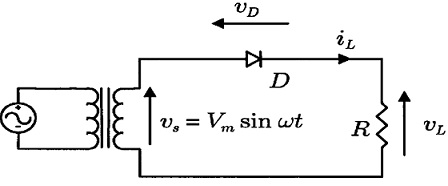
(1) The circuit above shows a simple half wave rectification circuit and you are required to determine the following parameters at the output of the load
a) The current wave form in the load
b) The average DC voltage
c) The RMS Voltage
d) The Form Factor
e) The Ripple Factor
f) The efficiency of the rectifier
g) The current wave form when an inductor is added to the load
h) How freewheeling diodes connected across the load improve the performance of the rectifier
In order to improve the above parameters a full-wave rectifier bridge is proposed and you have asked to quantify the improvements obtained by comparing the above parameters in both circuits.
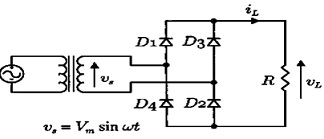
(2) For motors up to a few kilowatts the armature current can be supplied from either single-phase or three-phase mains, but for larger motors three-phase is always used. A separate thyristor or diode rectifier is used to supply the field current of the motor: the power is much less than the armature power, so the supply is often single-phase, as shown below
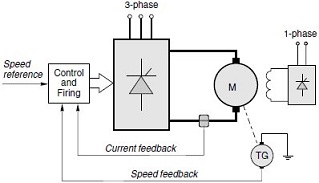
You are required to investigate the operation of the three phase rectifier bridge circuit shown above indentifying the following.
a) The circuit diagram for a three phase rectifier bridge connected to a delta/star Delta transformer.
b) The current wave forms on the on the AC side of the rectifier, when the motor is operating at low speed and high torque.
c) The current feedback loop requires the measurement of very large DC currents and you are required to investigate how this may be achieved.
d) The motor is to be used at low speeds and high torques you are required to comment on this and in particular what effect this has on the AC supply system suggesting how its performance may be improved.
e) A discussion of regenerative braking and why the system shown cannot be used for regenerative breaking
TASK 2 (l02,lo3) Understand the methods used for DC and AC motor control
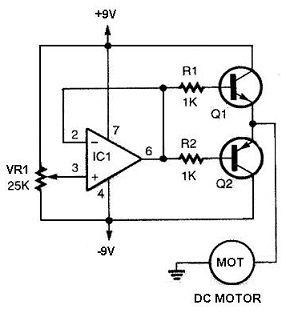
(3) The circuit above shows a simple DC control circuit that is to be used to control the speed of a DC motor using complementary transistors, you are required to produce a report on the operation of the above identifying the current and voltage waveforms across each of the transistors and identify the major disadvantage of such a circuit.
(4) The circuit shown below shows the principle components of DC speed controller using Pulse Width Modulation techniques you are required to produce a report on the operation of the circuit your report should include
a) The circuit diagrams for the MOSFET Bridge
b) A discussion of how the speed is controlled by varying the mark/space ratio of the pulse width modulator
c) A discussion of how bridge may be used for regenerative breaking
d) Comment on the power dissipated in the MOSFETS
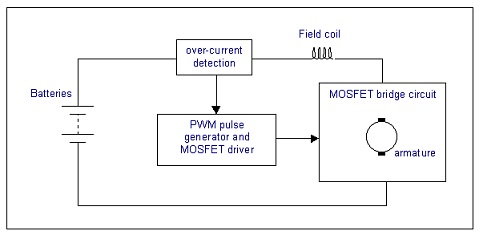
(5) The diagram below shows the arrange of two thyristor bridge rectifiers that are to be used to control the speed of DC motor that is to be used for rolling steel which requires control in all four quadrants. You are required to produce a report discussing
a) What is meant by four quadrant motor control?
b) What is meant by regenerative breaking and how the above bridges are capable of performing regenerative breaking?
c) Discuss the operation of the above thyristor bridges when the motor speed is reversed under full control.
d) The disadvantage of using the above configuration for when operating at low speed and high torque.
e) Identify the proposed advantages and disadvantages of using a DC chopper circuit fed from a three phase bridge rectifier.
f) What type of devices can be to measure the High DC currents required by the motor.
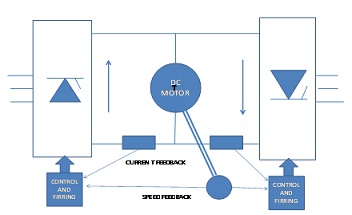
(6) Variable frequency drives are used to control the speed of AC induction motors. Investigate the design of variable frequency designs and identify the difference and advantages of using the following methods of producing variable frequency drives
a) Cyclometer variable frequency converters.
b) A bridge rectifier feeding a three phase inverter based on PWM techniques.
c) The advantages of high power induction motors over DC drives.
TASK 3 Understand other applications of power electronics
(7) Investigate the use of Power Electronic devices used in the modern Hybrid automobiles you are to produce:
a) A block diagram of the various power electronic devices and a diagram indicating how they are connected?
b) The Power Electronic devices used.
c) How Regenerative breaking is achieved identifying the energy flows during this mode of operation.
d) Automatic drive assist and how it is achieved.
e) Automatic shutdown/shutoff
(8) Investigate the use of Power Electronic Devices operation of UPS systems identifying the key parameters used in the design of the power electronic devices.